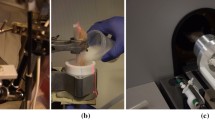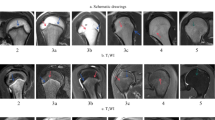Abstract
Purpose
This study aimed to apply a newly developed semi-automatic phantom-less QCT (PL-QCT) to measure proximal humerus trabecular bone density based on chest CT and verify its accuracy and precision.
Methods
Subcutaneous fat of the shoulder joint and trapezius muscle were used as calibration references for PL-QCT BMD measurement. A self-developed algorithm based on a convolution map was utilized in PL-QCT for semi-automatic BMD measurements. CT values of ROIs used in PL-QCT measurements were directly used for phantom-based quantitative computed tomography (PB-QCT) BMD assessment. The study included 376 proximal humerus for comparison between PB-QCT and PL-QCT. Two sports medicine doctors measured the proximal humerus with PB-QCT and PL-QCT without knowing each other’s results. Among them, 100 proximal humerus were included in the inter-operative and intra-operative BMD measurements for evaluating the repeatability and reproducibility of PL-QCT and PB-QCT.
Results
A total of 188 patients with 376 shoulders were involved in this study. The consistency analysis indicated that the average bias between proximal humerus BMDs measured by PB-QCT and PL-QCT was 1.0 mg/cc (agreement range – 9.4 to 11.4; P > 0.05, no significant difference). Regression analysis between PB-QCT and PL-QCT indicated a good correlation (R-square is 0.9723). Short-term repeatability and reproducibility of proximal humerus BMDs measured by PB-QCT (CV: 5.10% and 3.41%) were slightly better than those of PL-QCT (CV: 6.17% and 5.64%).
Conclusions
We evaluated the bone quality of the proximal humeral using chest CT through the semi-automatic PL-QCT system for the first time. Comparison between it and PB-QCT indicated that it could be a reliable shoulder BMD assessment tool with acceptable accuracy and precision.
Summary
This study developed and verify a semi-automatic PL-QCT for assessment of proximal humeral bone density based on CT to assist in the assessment of proximal humeral osteoporosis and development of individualized treatment plans for shoulders.






Similar content being viewed by others
Data availability
The data presented in this study are available on request from the corresponding author. The data are not publicly available due to the restriction of IRB.
Change history
01 April 2024
A Correction to this paper has been published: https://doi.org/10.1007/s00198-024-07064-x
Abbreviations
- BMD:
-
Bone mineral density
- vBMD:
-
Volumetric bone mineral density
- DXA:
-
Dual-energy X-ray absorptiometry
- QCT:
-
Quantitative computed tomography
- PB-QCT:
-
Phantom-based quantitative computed tomography
- PL-QCT:
-
Phantom-less quantitative computed tomography
- LDCT:
-
Low-dose chest computed tomography
- ROI:
-
Region of interest
References
Michel PA, Raschke MJ, Katthagen JC, Schliemann B, Reißberg I, Riesenbeck O (2023) Double plating for complex proximal humeral fractures: clinical and radiological outcomes. J Clin Med 12(2):696
Handoll HH, Brorson S (2015) Interventions for treating proximal humeral fractures in adults. Cochrane Database Syst Rev 6(11):Cd000434
Helfen T, Siebenburger G, Fleischhacker E, Gleich J, Bocker W, Ockert B (2020) Operative treatment of 2-part surgical neck type fractures of the proximal humerus in the elderly: cement augmented locking plate PHILOS vs. proximal humerus nail multiloc(R). Injury 51(10):2245–2252
Krappinger D, Roth T, Gschwentner M, Suckert A, Blauth M, Hengg C et al (2012) Preoperative assessment of the cancellous bone mineral density of the proximal humerus using CT data. Skeletal Radiol 41(3):299–304
Wang H, Xu X, Wang X, Qu W, Qing Y, Li S et al (2023) Performance optimization of biomimetic ant-nest silver nanoparticle coatings for antibacterial and osseointegration of implant surfaces. Biomater Adv 149:213394
Konstantinidis L, Helwig P, Hirschmuller A, Langenmair E, Sudkamp NP, Augat P (2016) When is the stability of a fracture fixation limited by osteoporotic bone? Injury 47(Suppl 2):S27–S32
Varga P, Grunwald L, Windolf M (2018) The prediction of cyclic proximal humerus fracture fixation failure by various bone density measures. J Orthop Res 36(8):2250–2258
Guo D, Liu X, Wang D, Tang X, Qin Y (2023) Development and clinical validation of deep learning for auto-diagnosis of supraspinatus tears. J Orthop Surg Res 18(1):426
Kwon J, Kim SH, Lee YH, Kim TI, Oh JH (2019) The rotator cuff healing index: a new scoring system to predict rotator cuff healing after surgical repair. Am J Sports Med 47(1):173–180
Oh JH, Song BW, Kim SH, Choi JA, Lee JW, Chung SW et al (2014) The measurement of bone mineral density of bilateral proximal humeri using DXA in patients with unilateral rotator cuff tear. Osteoporos Int 25(11):2639–2648
Engelke K, Chaudry O, Bartenschlager S (2023) Opportunistic screening techniques for analysis of CT scans. Curr Osteoporos Rep 21(1):65–76
Cheng X, Yuan H, Cheng J, Weng X, Xu H, Gao J et al (2020) Chinese expert consensus on the diagnosis of osteoporosis by imaging and bone mineral density. Quant Imaging Med Surg 10(10):2066–2077
Siris ES, Adler R, Bilezikian J, Bolognese M, Dawson-Hughes B, Favus MJ et al (2014) The clinical diagnosis of osteoporosis: a position statement from the National Bone Health Alliance Working Group. Osteoporos Int 25(5):1439–1443
(1994) Assessment of fracture risk and its application to screening for postmenopausal osteoporosis. Report of a WHO Study Group. World Health Organ Tech Rep Ser 843:1–129
Arentsen L, Hansen KE, Yagi M, Takahashi Y, Shanley R, McArthur A et al (2017) Use of dual-energy computed tomography to measure skeletal-wide marrow composition and cancellous bone mineral density. J Bone Miner Metab 35(4):428–436
Andersen L, Krueger D, Bernatz J, Binkley N, Anderson PA, Grogan B (2022) Humeral BMD can be measured with DXA and is lower in the surgical arm after total shoulder arthroplasty. J Clin Densitom 25(4):448–455
Budoff MJ, Malpeso JM, Zeb I, Gao YL, Li D, Choi TY et al (2013) Measurement of phantomless thoracic bone mineral density on coronary artery calcium CT scans acquired with various CT scanner models. Radiology 267(3):830–836
Schulze-Hagen M, Hubel C, Meier-Schroers M, Yuksel C, Sander A, Sahn M et al (2020) Low-dose chest CT for the diagnosis of COVID-19-a systematic, prospective comparison with PCR. Dtsch Arztebl Int 117(22-23):389–395
Xiongfeng T, Cheng Z, Meng H, Chi M, Deming G, Huan Q et al (2022) One novel phantom-less quantitative computed tomography system for auto-diagnosis of osteoporosis utilizes low-dose chest computed tomography obtained for COVID-19 screening. Front Bioeng Biotechnol 10:856753
Liu ZJ, Zhang C, Ma C, Qi H, Yang ZH, Wu HY et al (2022) Automatic phantom-less QCT system with high precision of BMD measurement for osteoporosis screening: Technique optimisation and clinical validation. J Orthop Translat 33:24–30
Wang L, Su Y, Wang Q, Duanmu Y, Yang M, Yi C et al (2017) Validation of asynchronous quantitative bone densitometry of the spine: Accuracy, short-term reproducibility, and a comparison with conventional quantitative computed tomography. Sci Rep 7(1):6284
Engelke K, Gluer CC (2006) Quality and performance measures in bone densitometry: part 1: errors and diagnosis. Osteoporos Int 17(9):1283–1292
Lee SY, Kwon SS, Kim TH, Shin SJ (2016) Is central skeleton bone quality a predictor of the severity of proximal humeral fractures? Injury 47(12):2777–2782
Miki RA, Oetgen ME, Kirk J, Insogna KL, Lindskog DM (2008) Orthopaedic management improves the rate of early osteoporosis treatment after hip fracture. A randomized clinical trial. J Bone Joint Surg Am 90(11):2346–2353
Zhang X, Zhu CX, He JQ, Hu YC, Sun J (2021) Correlation of CT values and bone mineral density in elderly Chinese patients with proximal humeral fractures. Orthop Surg 13(8):2271–2279
Pan Y, Shi D, Wang H, Chen T, Cui D, Cheng X et al (2020) Automatic opportunistic osteoporosis screening using low-dose chest computed tomography scans obtained for lung cancer screening. Eur Radiol 30(7):4107–4116
Pidgeon TS, Johnson JP, Deren ME, Evans AR, Hayda RA (2018) Analysis of mortality and fixation failure in geriatric fractures using quantitative computed tomography. Injury 49(2):249–255
Kamer L, Noser H, Popp AW, Lenz M, Blauth M (2016) Computational anatomy of the proximal humerus: an ex vivo high-resolution peripheral quantitative computed tomography study. J Orthop Translat 4:46–56
Kutlesa Z, Ordulj I, Peric I, Jerkovic K, Poljak D, Gavrilovic V et al (2023) Opportunistic measures of bone mineral density at multiple skeletal sites during whole-body CT in polytrauma patients. Osteoporos Int 34(4):775–782
Guo J, Zhou Y, Shang M, Chen W, Hou Z, Zhang Y et al (2022) Morphological characteristics of the surgical neck region in the proximal humerus at different ages. Eur J Med Res 27(1):102
Lee S, Hwang JT, Lee SS, Lee JH, Kim TY (2021) Greater tuberosity bone mineral density and rotator cuff tear size are independent factors associated with cutting-through in arthroscopic suture-bridge rotator cuff repair. Arthroscopy 37(7):2077–2086
Wang Y, Li J, Men Y, Wei W (2022) Menopause-related cortical loss of the humeral head region mainly occurred in the greater tuberosity. Front Endocrinol (Lausanne) 13:942803
Mischler D, Windolf M, Gueorguiev B, Nijs S, Varga P (2020) Computational optimisation of screw orientations for improved locking plate fixation of proximal humerus fractures. J Orthop Transl 25:96–104
Kim DM, Park D, Kim H, Lee ES, Shin MJ, Jeon IH et al (2020) Risk factors for severe proximal humerus fracture and correlation between deltoid tuberosity index and bone mineral density. Geriatr Orthop Surg Rehabil 11:2151459320938571
Lee SH, Dargent-Molina P, Breart G, Study EGEdlO (2002) Risk factors for fractures of the proximal humerus: results from the EPIDOS prospective study. J Bone Miner Res 17(5):817–825
Funding
This research was funded by The National Natural Science Foundation of China (U21A20390), the Special Foundation for Science and Technology Innovation of Jilin (20200201566JC, 20230204075YY), the Health Service Capacity Building Projects of Jilin Province (05KA001026009002), Graduate Innovation Program of Jilin University (No. 2023CX122), the 2023 Science and Technology Project of Jilin Provincial Department of Education (JJKH20231226KJ), and Jilin Province Natural Science Foundation (20190201218JC).
Author information
Authors and Affiliations
Corresponding authors
Ethics declarations
Conflicts of interest
None.
Additional information
Publisher’s note
Springer Nature remains neutral with regard to jurisdictional claims in published maps and institutional affiliations.
The original online version of this article was revised: In this article the affiliation details for Yuan-Zhi Weng and Chi Ma were incorrectly given as 'Joint International Research Laboratory of Ageing Active Strategy and Bionic Health in Northeast Asia of Ministry of Education, Jilin University, Changchun 130041, Jilin Province, China' but should have been 'Orthopaedic and Traumatology, The University of Hong Kong, Hong Kong, People’s Republic of China'.
Rights and permissions
Springer Nature or its licensor (e.g. a society or other partner) holds exclusive rights to this article under a publishing agreement with the author(s) or other rightsholder(s); author self-archiving of the accepted manuscript version of this article is solely governed by the terms of such publishing agreement and applicable law.
About this article
Cite this article
Guo, DM., Weng, YZ., Yu, ZH. et al. Semi-automatic proximal humeral trabecular bone density assessment tool: technique application and clinical validation. Osteoporos Int 35, 1049–1059 (2024). https://doi.org/10.1007/s00198-024-07047-y
Received:
Accepted:
Published:
Issue Date:
DOI: https://doi.org/10.1007/s00198-024-07047-y




